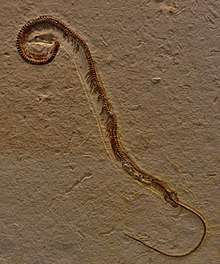Tetrapodophis
Tetrapodophis (meaning "four-footed snake" in Greek) is an extinct genus of squamate from the Early Cretaceous. It was previously thought to be one of the oldest members of Ophidia.[1][2] However it is currently thought to be a dolichosaurid based morphological analysis of the hind limbs. This species existed in the Cretaceous Period about 120 million years ago, located in modern day Brazil. This four legged animal is around 12 inches long, weighing around 15-17 ounces.
| Tetrapodophis | |
|---|---|
 | |
| Fossil in Bürgermeister-Müller-Museum | |
| Scientific classification | |
| Kingdom: | Animalia |
| Phylum: | Chordata |
| Class: | Reptilia |
| Order: | Squamata |
| Family: | †Dolichosauridae |
| Genus: | †Tetrapodophis Martill et al., 2015 |
| Type species | |
| †Tetrapodophis amplectus Martill et al., 2015 | |
Description

Tetrapodophis possesses small yet well-developed fore- and hindlimbs, a feature found in no snake living or extinct. Nevertheless, it shares many characteristics with modern snakes, including an elongate body, short tail, broad belly scales, a skull with a short snout and long braincase, curved jaws, and sharp hooked teeth. BMMS BK 2-2 contains bones of another animal in its gut, indicating that Tetrapodophis was carnivorous like most snakes. Other features such as short neural spines suggest that Tetrapodophis was adapted to burrowing, lending support to the hypothesis that snakes evolved in terrestrial environments (another hypothesis posits that they evolved in aquatic environments)[2]. The high number of vertebrae (upwards of 150) in Tetrapodophis and snakes is not seen in other burrowing reptiles with elongate bodies and reduced or absent limbs, meaning that it is most likely not an adaptation for a serpentine form of locomotion[1] Dolichosaurids are thought to be phyogenetically close to snakes as members of Ophidiomorpha, which explains some of the morphological similarities.
Discovery
The type species, Tetrapodophis amplectus, was named in 2015 on the basis of a complete skeleton (BMMS BK 2-2) preserved on a limestone slab in the Bürgermeister Müller Museum in Solnhofen, Germany, which was labeled as "unknown fossil" until its importance was recognized by paleontologist David Martill.[3] The specimen was later determined to come from the Early Cretaceous Crato Formation in Ceará, Brazil.
Classification
A phylogenetic analysis published alongside the original 2015 description of Tetrapodophis places it as a close relative of other early snakes such as Coniophis, Dinilysia, and Najash, but outside the crown group Serpentes, meaning that it branched off before the most recent common ancestor of all living snakes. Below is a cladogram from that analysis:[1]
| Ophidia |
| |||||||||||||||||||||||||||||||||||||||||||||||||||||||||||||||||||||
The interpretation of Tetrapodophis amplectus as an early fossorial snake was challenged by Caldwell et al. (2016), who considered it more likely to be a dolichosaurid squamate.[4][5]
References
- David M. Martill; Helmut Tischlinger; Nicholas R. Longrich (2015). "A four-legged snake from the Early Cretaceous of Gondwana". Science. 349 (6246): 416–419. doi:10.1126/science.aaa9208. PMID 26206932.
- Lee, Michael S. Y.; Palci, Alessandro; Jones, Marc E. H.; Caldwell, Michael W.; Holmes, James D.; Reisz, Robert R. (2016-11-01). "Aquatic adaptations in the four limbs of the snake-like reptile Tetrapodophis from the Lower Cretaceous of Brazil". Cretaceous Research. 66: 194–199. doi:10.1016/j.cretres.2016.06.004. ISSN 0195-6671.
- Yong, Ed (23 July 2015). "A Fossil Snake With Four Legs". Phenomena: Not Exactly Rocket Science. National Geographic. Retrieved 24 July 2015.
- Michael W. Caldwell; Robert R. Reisz; Randall L. Nydam; Alessandro Palci; Tiago R. Simões (2016). "Tetrapodophis amplectus (Crato Formation, Lower Cretaceous, Brazil) is not a snake". Society of Vertebrate Paleontology 76th Annual Meeting Program & Abstracts: 108.
- Geggel, Laura (October 28, 2016). "Mistaken Identity? Debate Over Ancient 4-Legged Snake Heats Up". Live Science.
External links

- Tetrapodophis as it may have been in life